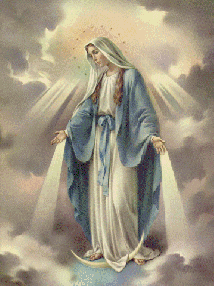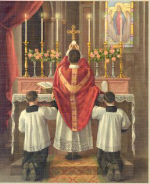Divine Mercy in the Lord of the Rings 11/9/2003 10:09:00 AM
By Joseph Pearce - Friends of Mercy Newsletter - Vol. 15, No. 7 | November/December 2003
It's no surprise that Tolkein's trilogy is interwoven with Catholic themes - he was a devout Catholic.
The Return of the King, the final part of Peter Jackson's blockbuster film adaptation of The Lord of the Rings trilogy, will be let loose on an expectant nation this December. During the coming months, it will be watched by millions of movie-goers throughout the world, most of whom will be unaware that they are watching a film version of a fundamentally religious and Catholic work.
The work's author, J.R.R. Tolkien, was a lifelong devout Catholic who poured his Catholic heart into the writing of the myth that is now captivating a new generation, half a century after its first publication. Tolkien insisted that the fact that he as "a Christian, which can be deduced from my stories, and in fact a Roman Catholic," was the most important and "really significant" element in his work. Indeed, it's not difficult to discover the manifestation of Divine Mercy in The Lord of the Rings.
In this epic tale of good and evil, the great Ring of power must be destroyed otherwise it will be used by the Dark Lord Sauron to enslave all of Middle Earth. The hobbit Bilbo and then his nephew Frodo come into possession of the Ring from Gollum - a hobbit who has been reduced to a crazed and pitiable shadow of his former self through long exposure to the Ring.
With his trusty servant Sam, Frodo accepts the daunting mission of destroying the Ring by returning to the fire of Mount Doom, where it was forged by the Dark Lord. On their quest to reach Mount Doom in the heart of the evil land of Mordor, Frodo and Sam's steps are dogged by Gollum, who willing to do anything to regain possession of the Ring himself.
The issue then becomes do Frodo and Sam take matters into their on hands by killing Gollum, or do they show him mercy even though he poses a threat to them at points on their arduous journey?
Knowing his treacherous intent, Frodo had wished that Gollum has been killed: "What a pity that Bilbo did not stab that vile creature when he had a chance!"
"Pity?" replied Gandalf, the wise wizard. "It was Pity that stayed his hand. Pity, and Mercy." Gandalf believes Gollum is mystically bound up with the fate of the Ring. "My heart tells me that he has some part to play yet, for good or ill, before the end; and when that comes, the pity of Bilbo may rule the fate of many - yours not least." (
Caution: Spoilers ahead for those who haven't read the book yet!)
These words are recalled later by Frodo when he, too, has the chance to kill Gollum. Like Bilbo, Frodo also chooses the path of mercy over vengeance, and, like Bilbo, his charitable choice comes to "rule the fate of many." At the climatic moment on Mount Doom, Frodo finds that he cannot, at the very last, cast the Ring into the fire. On the very brink of success, he finds himself on the verge of final,and fatal, failure.
It is at this crucial moment that Frodo and Middle Earth itself are saved by Gollum who rushes forward and bites the Ring from Frodo's finger before falling into the abyss, destroying himself and the Ring in the process.
The scene is not only a triumph of divine providence over fate, it is the triumph of Divine Mercy, in which free will, supported by grace, is fully vindicated. According to Tolkien himself, Frodo has been saved "because he had accepted the burden voluntarily, and had then done all that was within his utmost physical and mental strength to do. He, and the Cause, were saved - by mercy: by the supreme value and efficacy of pity and forgiveness and injury" (from Tolkien's Letters).
In the Church, the greatest manifestation of Divine Mercy is, of course, the Incarnation and the Crucifixion. At its deepest, Tolkien's myth serves as a reflection of this archetypal mercy. The journey of Frodo and Sam is emblematic of the Christian's imitation of Christ in carrying the cross.
Tolkien makes the parallel even more explicitly. "I should say," he wrote, explaining the final climatic moments on Mount Doom when the Ring is finally unmade, "that within the mode of the story [it] exemplifies (an aspect of) the familiar words: 'Forgive us our trespasses as we forgive [those who] trespass against us. Lead us not into temptation but deliver us from evil.'"
Furthermore, Tolkien makes the Christian dimension even more unmistakable in the fact that the climatic destruction of the Ring - and in consequence the destruction of the Dark Lord who had forged it - occurred on "the twenty-fifth of March." That's believed to be the date Christ was crucified. It is also, of course, the Feast of the Annunciation, the celebration of the absolute center of all history as the moment when God Himself became incarnate as man.
As a Catholic, Tolkien knew March 25 was the date in which God had "unmade" Original Sin, which, like the Ring, has brought humanity under the sway of the Shadow. If the Ring, which is unmade at the culmination of Tolkien's Quest, is the "one ring to rule them all... and in the darkness bind them," the Fall was the "One Sin to rule them all... and in the darkness bind them." On the twenty-fifth of March the One Sin, like the One Ring, has been "unmade," destroying the power of the Dark Lord.
It is very comforting in the midst of these dark days that the most popular book of the twentieth century, and the most popular movie of the new century, draw their power and their glory from the light of the Gospel.
*****
Joseph Pearce is Writer in Residence at Ave Maria University in Ypsilanti, Michigan, and author of Tolkien: Man and Myth (
Ignatius Press).










